Packard Gallery II (372 Commercial St.)
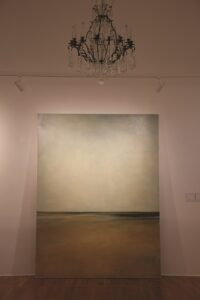
Koryna Boudinot is from San Francisco but now lives in Wellfleet. She likes the Packard Gallery because of the space — there’s plenty of room for large-scale art like Anne Packard’s Beachscape. “I come almost every week and enjoy this space specifically,” says Boudinot. “These large-scale pieces are so natural and organic. They fit in the space really well.”
She says she’s not in the market for any of the canvases she loves because she can’t afford them. But if she ever took one home and found a wall big enough, she’d place the art in “a central viewpoint.” She gestures toward the gallery’s entryway, directly across from Beachscape. “I like when you come in through these doors,” she says, “how they always have a large-scale piece right here. I think it’s perfect.”
Ray Wiggs Gallery (432 Commercial St.)
Abigail Duncan of New Canaan, Conn. peers intently at Mark Freedman’s Labyrinth. “When I turned the corner,” she says, “it immediately struck me, the size and the perspective.”
It’s a landscape but not a typical one: a wash of industrial, rectangular roofs and the gray streets that divide them, dark and deliberate in the foreground and stretching infinitely into the background. “You would think it might not be interesting,” says Duncan, moving closer to the painting. “But it is so interesting. When you get up close to it you can see so many textures, and it looks like there’s something underneath: some sort of textured wood, or tape.”
Duncan is an art teacher at Saxe Middle School in New Canaan. “It’s a very exciting piece for me,” she says. “It makes me want to paint.” She’s not an artist, she states resolutely. The man beside her, Pete Bower, also from New Canaan, shakes his head — “She’s an artist,” he says. Duncan continues: “Looking at this gives me aspirational goals, and I don’t always feel that way.”
Larkin Gallery (405 Commercial St.)
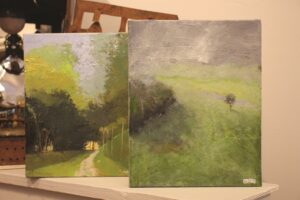
Artist Catherine Meeks points to three of her paintings displayed at the Larkin Gallery. “All three were done last summer when I was awarded a residency in France,” she says. “We stayed in a big 18th-century chateau. There were 15 of us and no guidelines. I did scenes from the property — these were areas that I walked every day with the friends I made there.” She says the best part of the residency was the friendships she formed. “Painting is really a kind of isolating experience,” she says. “If you have the opportunity to meet other artists, it’s wonderful.”
Meeks lives in Acton. “It’s small town,” she says. “There really aren’t any galleries.” The Provincetown gallery stroll is an opportunity to share her work, which she loves to do. “I love when people come to my studio,” she says. “They tend to invite themselves. I’m happy to have people look and to share what I’m thinking and doing.”
Greg Salvatori Gallery (366 Commercial St.)
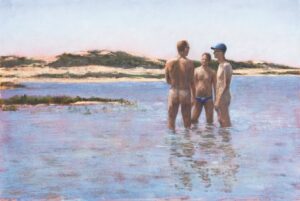
At the Greg Salvatori Gallery, artist Eric Price’s newest series, “The Beach Only Few Can See,” delights David Chen, who lives in Boston and Provincetown. Holding a small dog in his arms, he considers the paintings. All involve men in or near the water. Some are nude; some appear angelic, with white wings and masks; and some are wingless mortals, carrying surfboards or standing knee-deep in the ocean.
Chen decides he likes Beach Chat the best. “It feels very P’town, very free,” he says. “It’s a couple of guys who are not clothed, one with clothing — everything feels very natural.” He likes the way the landscape interacts with the people: “It’s a combination of conservative P’town and less conservative P’town.”
Galeria Cubana (357 Commercial St.)

Charles Martel, a psychotherapist from Boston, feels drawn to Untitled (Blue landscape) by Dairan Fernandez de la Fuente. In the painting, one figure looks toward the sea and another looks in the opposite direction toward land. “There’s a sense of looking both toward the past and toward the future and what that might represent,” says Martel. “There are abstract aspects about the piece but also lines that feel very present.” He says the benches that face the water make the piece feel welcoming. “It’s an interesting concept, the idea of both movement and rest.”
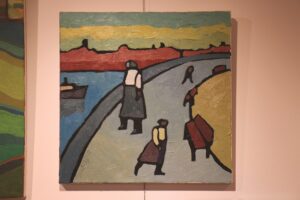
On Center Gallery (352 Commercial St.)
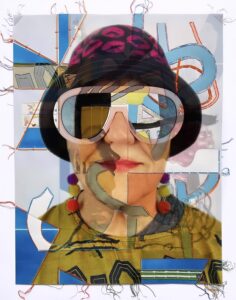
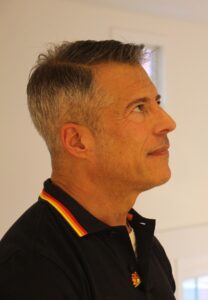
Upstairs at On Center Gallery, Joey Brock’s vibrant and dizzying pieces line the walls. Mark Weinress, who lives in the Provincetown’s East End, studies Lost in Translation. “This is the first one that caught my eye,” he says. “My eyes cannot stay still while looking at it!”
He’s retired now, but Weinress was a commercial interior designer and knows a thing or two about leading lines and focal points in art. “If you look at even a very traditional painting, the artist will do things to draw your eye to where the artist wants you to look,” he says. Joey Brock’s pieces do that, he says, but in a way that feels almost cacophonous. “Your eye is just constantly following these angles.” He moves to Road Trippin, a piece further along the wall. “This one pulls you around. You get to the center and look at her glasses, and it’s like, ‘Well, now what’s going on?’ ”
Woodman/Shimko Gallery (346 Commercial St.)

William Breen from Baltimore, Md. says he likes Sunny Nest by Laura Tryon Jennings. “Although it’s absent of human figures, it’s very obvious that humans have been there,” he says. He looks closer at the scene, which seems to emanate warmth: the sunlight, the mussed bedding. “There’s still that humanity. The water on the bedside table, the wrinkle of the sheets. It’s been slept in, lived in, but still, no people. It’s something an outside viewer wouldn’t usually get to see. It’s like an intrusion.”



